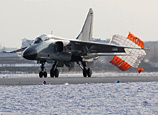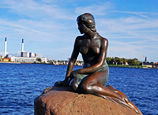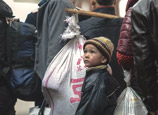
Residents of Aohan Banner, Chifeng, in the Inner Mongolia autonomous region, are fighting the biggest snow disaster to hit the region in two decades.
The newly cleaned road connecting the banner seat and the countryside became snowy and icy again as another heavy snow hit the eastern part of Inner Mongolia on Sunday.
Off-road vehicles can drive at less than 30 km/h along the slippery road covered by thick ice.
Temperatures may have jumped to -15 C from the low of -30 C this winter, and sunshine has melted some snow on the roofs. But it is still a long away from the end of misery for local shepherds.
"This is the biggest snow disaster I've ever seen in my life," said Yu Haishui, 58, a villager in Mendouyingzi village, Fengshou township, who once raised more than 200 sheep. However, he now owns only 75.
"I have to sell the sheep in advance, or the forage will be far from enough. Some are only lambs, but I have to because they suffer from malnutrition."
Yu said a sheep usually sells for about 1,400 yuan ($225), but now he will sell it for less than 1,000 yuan. A dozen of his sheep have died from the cold.
"The snow is on average 40 centimeters thick. It covered the straw in the corn fields, which is the major source of forage," said Zhang Ruiguang, a resident of the same township. "We have no way to pull it out of the fields, and even some of my corn is buried by snow," said the 45-year-old villager, who takes his flock to pasture on the nearby hills every day.
"It used to be for the sheep to look for food, like grass," he said with an embarrassed smile. "But now it's only exercise for them because everywhere is nothing but white wildness."
Sun Zefu, a leading local vegetable grower, says his greenhouse collapsed twice from the snowfall, causing a 200,000-yuan loss. He says the government has offered him 30,000 yuan to establish a new house, but he worries about a 700,000 yuan loan he took out in early 2012.
According to Yang Wei, the township chief, they plan to contact the bank and vouch for the stricken villagers who have loans to postpone repayment.
Nevertheless, according to Zhang Yong, deputy head of the agriculture and husbandry bureau of Aohan, the banner lacks enough financial support from upper-level government to compensate all the stricken villagers because the affected area in Chifeng is too wide.
According to the local civil affairs bureau, 86 percent of the land in Chifeng has been covered by snow. Some 32,000 head of livestock have died and more than 2,700 vegetable greenhouses collapsed due to the disaster. The total economic loss is about 300 million yuan.
Zhang Yong said the banner government has recently gathered 500,000 yuan to help transport straw from the field.
The bureau is focusing on ways to widen the source of feed.
"I can feed the sheep in the shed, but I guess they are still only about 20 percent full and I even saw some sheep beginning to eat each others' wool," Zhang Ruiguang said. "However, agricultural technicians showed us how to mix straw with some refined feed, which can at least temporarily get us through the difficulties."
According to Chen Zhimin, a senior agricultural technician in Fengshou township, the feed will cost an average 40 percent more, but it will be better for the sheep during the food shortage.
"We have promoted refined feed among the shepherds for years, but only got a frigid response," Chen said. "Perhaps the disaster will also help them change their rough pasturing methods and apply some new ways to counter emergencies."
"Life will continue. I hope the weather will come back to normal after Spring Festival," Yu said. "Once the snow melts and I can pull more straw out of the fields, everything will be fine."
Spring Festival is also when most local villagers' forage will be used up.
"But who knows what will happen if heaven gives us another heavy snow," Yu said.
















 Beijing style: Duck, opera, fog and cough...
Beijing style: Duck, opera, fog and cough...


![]()
